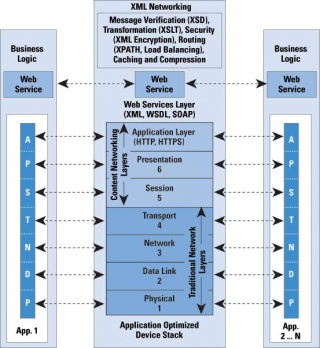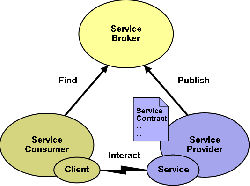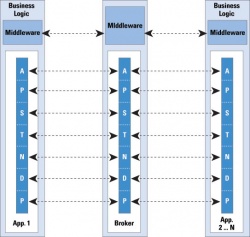SOA enhancements through XML Networking
From Computing and Software Wiki
| Line 35: | Line 35: | ||
*Can improve performance of optimized parsers. [http://www.xml.com/pub/a/1999/12/dtd/index.html [9]] | *Can improve performance of optimized parsers. [http://www.xml.com/pub/a/1999/12/dtd/index.html [9]] | ||
====XSLT==== | ====XSLT==== | ||
| - | + | *Stands for Extensible Stylesheet Language Transformation. | |
| + | *Transforms a given XML document into another document (usually XML or XHTML) based on content filtering and manipulation. [http://en.wikipedia.org/wiki/XSL_Transformations [10]] | ||
====XPath==== | ====XPath==== | ||
====XQuery==== | ====XQuery==== | ||
| Line 55: | Line 56: | ||
*'''8.''' Hugo Haas [http://www.w3.org/2003/Talks/0521-hh-wsa/slide5-0.html SOA Diagram], W3C.org May 21, 2003. | *'''8.''' Hugo Haas [http://www.w3.org/2003/Talks/0521-hh-wsa/slide5-0.html SOA Diagram], W3C.org May 21, 2003. | ||
*'''9.''' Simon St. Laurent [http://www.xml.com/pub/a/1999/12/dtd/index.html Describing your Data: DTDs and XML Schemas], XML.com December 1, 1999. | *'''9.''' Simon St. Laurent [http://www.xml.com/pub/a/1999/12/dtd/index.html Describing your Data: DTDs and XML Schemas], XML.com December 1, 1999. | ||
| + | *'''10.''' [http://en.wikipedia.org/wiki/XSL_Transformations XSLT], Wikipedia March 27, 2008. | ||
*'''0.''' Hao He [http://webservices.xml.com/pub/a/ws/2003/09/30/soa.html What Is Service-Oriented Architecture], XML.com September 30, 2003 | *'''0.''' Hao He [http://webservices.xml.com/pub/a/ws/2003/09/30/soa.html What Is Service-Oriented Architecture], XML.com September 30, 2003 | ||
Revision as of 01:16, 7 April 2008
Service Oriented Architecture (SOA) enhancements through Extensible Markup Language (XML) Network has been a very discussed topic in the last few years. The performance and scalability of current SOA models are not sufficient to satisfy the increasing business demand of today's world. Web services for major companies are faced with extreme throughput issues that affect all the underlying applications that depend on such services. [1] This wiki discusses the approaches that can be taken to accelerate this service-sharing process by expanding the use of XML technologies throughout the middleware of the SOA framekwork. [2]
Contents |
SOA Overview
The web services concept provides a framework for sharing services across a network (such as the internet). Each of these services represent a group of objects and resources that are combined to provide a tool for business applications. Service-oriented architectures use these tools to build their custom applications: various services are grouped together to form the desired product (see figure 1). Therefore naturally the key factor for the success of SOA is interoperability. This means that services must be reachable from within any development framework: Java SE, .NET, etc. For such concept to become true various standards and regulations must be specified. [3] Such components will be discussed in the following section.
SOA Components
The main "ingredients" for a web service layer, and essentially a service-oriented architecture are: UDDI, WSDL, SOAP and HTTP. Together they specify what the web service is and how to reach it, which is all the client application needs to know.UDDI
- Stands for Universal Description,Discovery and Integration.
- Sponsored by OASIS.
- An XML-based registry that allows businesses to list and search for web services. [4]
WSDL
- Stands for Web Services Description Language.
- An XML-based language that describes a web service.
- The 2.0 version is a W3C recommendation. [5]
SOAP
- Stands for Simple Object Access Protocol.
- A protocol for exchanging XML-based messages over a network.
- Provides a standard message format for services to use. [6]
HTTP
- Stands for Hypertext Transfer Protocol.
- It is used to transfer information through a network (intranet, of world wide web).
- Allows for a communication channel between a client and a server. [7]
Enhancements through XML Networking
As noted above, all aspects of a service-oriented architecture are based on the XML standard. However it is strange to realize that a large number of existent SOA-based systems do not take advantage of the growing arsenal of XML-related technologies. [1] In its current framework state, a large incoming SOAP request can really damage the throughput of a network: this message needs to be de-serialized, then proper networking routing logic applied, serialized again, routed to the destination service, process the response, and finally build the outgoing SOAP envelope. The efficiency of all these steps can be improved by applying XML-related tools at the network level, and therefore avoid the penalty of serialization/de-serialization of large SOAP messages. [2]
Overview of Technologies
Below is a brief listing of the main XML technologies that can be utilized to enhance the networking of web services.
XSD
- XML Schema (XSD) is a W3C Standard that specifies the rules and structure of its related instances.
- Designed to replace Document Type Definition (DTD), allowing for more complex internal structures.
- Can improve performance of optimized parsers. [9]
XSLT
- Stands for Extensible Stylesheet Language Transformation.
- Transforms a given XML document into another document (usually XML or XHTML) based on content filtering and manipulation. [10]
XPath
XQuery
XML Encryption
Integrating XML Network

FastSOA: the next step
References
- 1. Frank Cohen FastSOA: Accelerate SOA with XML, XQuery, and native XML database technology IBM.com February 7, 2006.
- 2. Silvano Da Ros Boosting the SOA with XMLNetworking, Cisco.com December 1, 2006.
- 3. Service-oriented architecture, Wikipedia April 6, 2008.
- 4. UDDI, Wikipedia March 25, 2008.
- 5. WSDL, Wikipedia March 7, 2008.
- 6. SOAP, Wikipedia April 3, 2008.
- 7. HTTP, Wikipedia April 6, 2008.
- 8. Hugo Haas SOA Diagram, W3C.org May 21, 2003.
- 9. Simon St. Laurent Describing your Data: DTDs and XML Schemas, XML.com December 1, 1999.
- 10. XSLT, Wikipedia March 27, 2008.
- 0. Hao He What Is Service-Oriented Architecture, XML.com September 30, 2003
External Links
- The XML Schema Technology
- W3C Standard
- Document Type Definition (DTD)
- Extensible Markup Language (XML)
- OASIS
See Also
Signature
Demagaal 19:34, 6 April 2008 (EDT)


